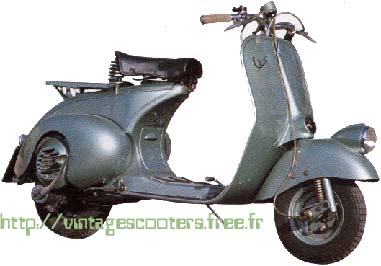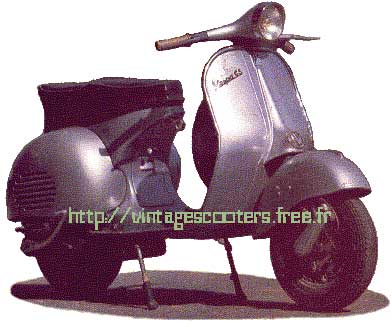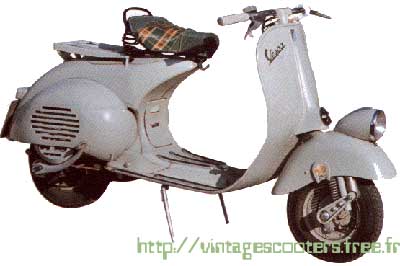| Vespa 90 - 1963 | |
| Year(s) of production | | 1963 / 67 | | 1967 / 88 |
| VIN | | V9A1T | | V9A1T |
| Numbeéo | | 1001 / 28000 | | 28001 / 300026 |
| Production | | 27000 | | 272026 |
This vespa 90 is the first model with an engine of that cubic capacity. From this model will see the birth of the
Super Sprint and Sprinter.
 180 - 1966 Hurricane
180 - 1966 Hurricane
| Year(s) of production | | 1964 / 68 |
| VIN | | VSC1T |
| Number | | 001001 / 0036700 |
| Production | | 35700 |
This vespa was an existing version of 180 SS models. It's the "Grimstead Hurricane". A different paint scheme from other versions of the 180 SS. The two colors were the "Vespa White" and the "Vauxhall cavern Green". 180 SS model was the last vespa designed with a Piston-ported type motor. Rally models will replaced the 180 SS after that.
It was in 1964 that the 180 SS will be designed.
On the evolution of the motorisation, 180 SS will replaced the older GS model. The look will be also modified for the first time with this model. Improvements included a trapezoidal headlight. The drawing will be more square after this date and for every models to come. This new look is still controversial for today. 180 SS will also be the first vespa after the GS, fitted with a spare wheel and a glove box as standard features. Unfortunately, it was also the last model to have been fitted with this special kind of fork and motor design.
Last versions of the 180 SS were produced with a rond headlight and a speedometer cluster from "Rally" models.
| Vespa 50 Super Sprint - 1965 |
| Year(s) of production | | 1965 / 71 |
| VIN | | V5SS1T |
| Number | | 1001 / 3525 |
| Production | | 4525 |
This model was also produced with a 90cc motor but was never imported in France. SS models were fitted with a smaller bulged legshield and a glove box designed to looks like an auxiliary fuel tank, just over the spare wheel, mounted in the center of the floor. A chromed exhaust silencer will gives to it a sportive look. These models were only produced in 3 colors. Red, blue or white.
| Vespa 90 Super Sprint - 1965 |
| Year(s) of production | | 1965 / 71 |
| VIN | | V9SS1T |
| Number | | 1001 / 6309 |
| Production | | 5309 |
The 90 SS was never imported in France. This model like the 50 SS models were fitted with a smaller bulged legshield and a glove box designed to looks like an auxiliary fuel tank, just over the spare wheel, mounted in the center of the floor. A chromed exhaust silencer will gives to it a sportive look. These models were only produced in 3 colors: brillant red, blue or white.
| Vespa 125 Nuova - 1965 |
| Year(s) of production | | 1965 / 67 |
| VIN | | VMA1T |
| Number | | 01001 / 018100 |
| Production | | 17100 |
The 125 Nuova is the big novelty of 1965. The engine conception is new for a 125cc. The frame is quite similar to the 50 and 90cc.
This model was aporary measure as a prelude to the 125 Primavera in 1967.
Vespa 150 Super - 1965 / 125 Super "MotoVespa" (spanish licence)
| | | Vespa 150 Super | | Vespa 125 Super |
| Year(s) of production | | 1965 / 79 | | 1965 / 69 |
| VIN | | VBC1T | | VNC1T |
| Number | | 1001 / 554808 | | 01001 / 025146 |
| Production | | 553808 | | 24146 |
In the "Super" type, there is two versions : the 125 and the 150. Esthetically they are similar.
This Vespa with the
150 Sprint were available with the "Automatic Fuelmix". The 150 Super is equal to the
GL (not the
french model), but it is fitted with 8" tyres and a different headlight.
Some 125 Super (photo 2) were also produce during the 68, but under the spanish licence "MotoVespa". The cowls are one piece with the frame (like the Primavera), but it has a glove-box in the legshield and a spare wheel fitted around the taillight.
| Vespa 150 Sprint - 1965 |
| Year(s) of production | | 1965 / 67 | | 1967 | | 67 / 70 | | 71 / 74 |
| VIN | | VLB1T | | VLB2T | | VLB1T | | VLB1T |
| Number | | 01001 / 050000 | | 050001 / 051523 | | 050001 / 0150750 | | 1150751 / 1205477 |
| Production | | 49000 | | 1523 | | 100750 | | 44727 |
This model is similar to the GL, except that it has a better compression and a four gear-box, and 10" in wheels.
 |
| Year(s) of production | | 1966 / 67 | | 1967 / 70 |
| VIN | | V5A1T | | V5A1T |
| Number | | 500001 / 530932 | | 540001 / 637063 |
| Production | | 30932 | | 97063 |
In 1966, the 50's family see a new vespa, the 50 L.
| Vespa 125 GT - 1966 |
| Year(s) of production | | 1966 / 73 |
| VIN | | VNL2T |
| Number | | 30001 / 81582 |
| Production | | 51582 |
This vespa is similar to the
Sprint with a trapezoïdal headlight.
In fact, this model was destinate to the exportation, it was never sold in Italy, in a way, this was a 125 Sprint, like the italians used to call it.
The GT replace "
the old GT".
| | |  | | |  |
| Year(s) of production | | 1967 / 83 | | | 1976 / 92 |
| VIN | | VMA2T | | | VMB1T |
| Number | | 020001 / 0240329 | | | 1101 / 150143 |
| Production | | 220329 | | | 149043 |
The Primavera's frame is quite the same as the
V5A. In regard to the V5A, the Priamvera has an engine of 121.17cc, a bigger round headlight, a bigger handlebar, a four speed gear-box and 3.00x10 in wheels. So with is 73 kg and is 4 speed, it is capable of 85km/h top speed, and 70km/h cruising speed.
| Vespa 125 GTR - 1972 |
| Year(s) of production | | 1968 / 78 |
| VIN | | VNL2T |
| Number | | 100001 / 151788 |
| Production | | 51788 |
This model replace the
GT "Sprint". But physically, it remain the same.
The GTR serie will havre the reputation of being very reliable.
| Vespa 180 Rally - 1968 |
| Year(s) of production | | 1968 / 73 |
| VIN | | VSD1T |
| Number | | 001001 / 0027495 |
| Production | | 26495 |
This vespa, both on the visual aspect, and the evolution at Piaggio, is the
SS 180's substitute. It was designed for longer journeys and had a more powerful engine, for the sporting scooterist who required a higher performance scooter.
And this Rally 180 will be replaced in 1972 by the "
Rally 200 electronic". It had a similar chssis to that of the 180.
| Vespa 50 R - 1969 |
| Year(s) of production | | 1969 / 71 | | 71 / 83 |
| VIN | | V5A1T | | V5A1T |
| Engine | | | | V5A2M |
| Number | | 700001 / 752188 | | 752189 / 938761 |
| Production | | 52188 | | 186573 |
The engine fitted in the second serie (from 1971 to 83), is the same as in the
50 Special (from 1972 to 75).
Vespa 50  - 1969 - 1969 |
| Year(s) of production | | 1969 / 72 | | 72 / 75 | | 75 / 76 |
| VIN | | V5A3T | | V5B2T | | V5B4T |
| Engine | | | | V5A3M | | |
| Number | | 1001 / 5708 | | 1001 / 3667 | | 1101 / 1533 |
| Production | | 4708 | | 2667 | | 433 |
This is equipped of an electric-starter, a square headlight, a contact-key on top of the handlebar. The kick-starter is gone, even the horn cover is different of the others 50. It is connected with two 6 volts's batteries. This vespa will be especially for the Italian and English market.
| Vespa 50 Special - 1969 |
| Year(s) of production | | 1969 / 72 | | 72 / 75 | | 75 / 83 |
| VIN | | V5A2T | | V5B1T | | V5B3T |
| Engine | | | | V5A2M | | V5A4M |
| Number | | 1001 / 96013 | | 1001 / 95671 | | 1101 / 565056 |
| Production | | 95013 | | 94671 | | 363956 |
This 50cc has a four gear speed and 3,00x10 in wheels.
 |
| Year(s) of production | | 1969 / 79 |
| VIN | | VLB1T |
| Number | | 0150001 / 0368119 |
| Production | | 218119 |
| Vespa 50 Sprinter - 1971 |
| Year(s) of production | | 1971 / 73 |
| VIN | | V5SS2T |
| Number | | 4001 / 4515 |
| Production | | 515 |
71 see the cease of
50 N's production, and the arrive of the new 50 Sprinter and 90 Sprinter that substitute the
50 and
90 Super Sprint.
| Vespa 90 Race - 1971 |
| Year(s) of production | | 1971 / 74 |
| VIN | | V9SS2T |
| Number | | 7001 / 10516 |
| Production | | 3516 |
| Vespa 200 Rally - 1972 |
| Year(s) of production | | 1972 / 79 |
| VIN | | VSE1T |
| Number | | 001001 / 0042275 |
| Production | | 41275 |
The Rally 200 is the evolution of the
180. The "Rally 200 electronic" is produced with the same chassis.
La roue de secours est placée dans l'aile gauche, la suspension avant est très plongeante.
C'est aussi la première Vespa à allumage électronique, et sa motorisation de 200 cm3 en fait une vespa très sportive. D'une certaine manière, cette vespa est l'aboutissement des recherches et des évolutions menées depuis 1946. Aucune vespa standard ne peut battre ce modèle.
Le graissage séparé était proposé en option à l'époque. La Rally était disponible en rouge, en gris et en orange.
Les modèles, jusqu'en 1975 inclus, sont équipés d'un coupe-circuit situé sous la selle à côté du porte-paquet ; de clignotants au bout des poignées de commande, sur certains modèles. Ces clignotants sont alimentés par une batterie de 6 volts placée dans l'aile gauche au centre de la roue de secours.
Les premiers modèles ne comportent pas de contacteurs sur le haut du guidon, mais un badge Piaggio à la place ; c'est à partir de 1976 que la Rally est équipée d'une clé de contact sur le haut du guidon.
En 1976, les badges sont aussi changés. Il n'y a plus le badge "Vespa" avec l'écriture à l'ancienne à l'avant, mais celui que l'on retrouve sur les PX.
| Vespa 50 SR - 1975 |
| Année(s) de production | | 1975 / 79 |
| Préfixe | | V5SS2T |
| Numéro | | 1001 / 10579 |
| Production | | 579 |
 | | Ce modèle était destiné au marché allemand.
Il est l'équivalent de la Vespa 50 Sprinter.
On peut noter le feu arrière de type "Rally" que l'on retrouve également sur les Primavera ET3 destinés au marché allemand, les clignotants en bout de guidon, et le pot d'échappement caractéristique au moteur des 50 SS dans sa version non-chromé.
|
| | | |
 | | Le guidon est celui du Primavera et la descente de klaxon en plastique celle du 50 Special.
Elle est chaussée de pneu en 10 pouces. |
 |
| Year(s) of production | | 1975 / 78 |
| VIN | | VNL3T |
| Number | | 1101 / 29804 |
| Production | | 28704 |
Que dire de cette vespa, si ce n'est qu'elle est un modèle très peu connue.
Et qu'elle est la dernière vespa au forme encore arrondi avant les PX de la "nuova linea".
Vespa 125 Primavera ET3 - 1976
| | |  |
| Année(s) de production | | 1976 / 92 |
| Préfixe | | VMB1T |
| Numéro | | 1101 / 150143 |
| Production | | 149043 |
La nouvelle
Primavera, appelé ET3, reprend les même caractéristiques que la précédente sauf que désormais le piston est à trois transferts, et que l'allumage est électronique. Elle garde la même vitesse de pointe que la Primavera, mais elle a plus de couple, et atteint donc plus rapidement sa vitesse de croisière. Le pot d'échapppement est le même que celui de la
90SS. Elle se différencit par ses bandes adhésive sur les ailes (avec l'inscription "ELECTRONIC" sur l'aile gauche) et le garde-boue.
| Vespa 100 - 1978 |
| Année(s) de production | | 1978 / 83 |
| Préfixe | | V9B1T |
| Numéro | | 1101 / 28904 |
| Production | | 27804 |
Avec une cylindrée de 96,12 cm3 (alésage 49 mm / course 51 mm), un mélange à 2% et sa boite à 3 vitesses, cette vespa peut atteindre les 70km/h.

 / Ape A - 1948
/ Ape A - 1948
 "Calessino" / TriVespa - 1949
"Calessino" / TriVespa - 1949



 - 1958
- 1958















 - 1969
- 1969















 .
.














 -
-